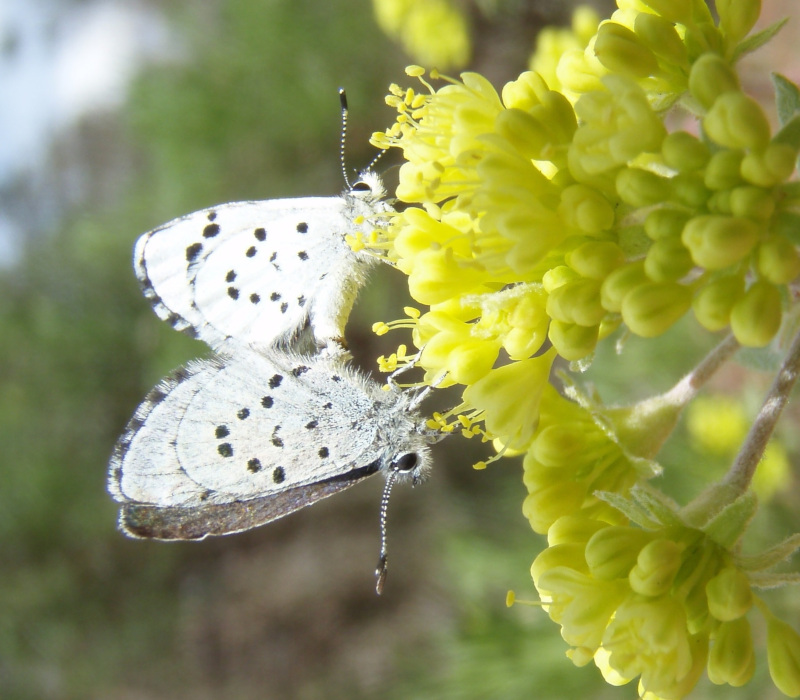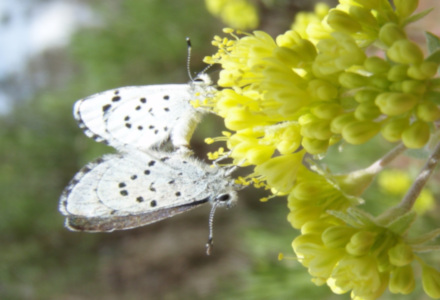
Leona’s Little Blue Facts
- Delightfully, the lighthearted term of Leona’s Little Blue serves as the generally accepted common name for a stunning variety of Lepidoptera. However, this truly marvelous, and rarely photographed, little invertebrate also bears another name.
- That’s due to the fact that it also has the somewhat difficult to pronounce scientific name of the Philotiella leona. This nonetheless tongue-twisting term is rarely used, except by professional entomologists and scientific researchers.
- Regardless of what term one uses to refer to it, one fact remains consistent. That’s the fact that this marvel of Nature amazes those who learn of it. This holds true due to the simple fact that the species remained unknown until 1995.
- At that time, though, Leona and Harold Rice made the surprising discovery of the delicately beautiful species. But, the official confirmation that this fabulous invertebrate constituted a previously unknown species did not occur until 1999.
- Additionally, based on its known population base, the Leona’s Little Blue qualifies as the 7th rarest species of butterfly known to man. In point of fact, estimates currently place its population at somewhere between 1,000 – 2,000 individuals.
- However, for currently unknown reasons, the IUCN presently has no listing for the incredible arthropod. Such a listing would appear on the organization’s Red List of Threatened Species. That could change, however, as its situation does.
- But, the country in which this marvelous insect appears understandably lists it under its own Endangered Species Act. Finally, as a result of its limited numbers, it remains at severe risk from both habitat loss and climate change.
Related Articles
Leona’s Little Blue Physical Description
The name of the extremely delicate-seeming Lepidoptera named the Leona’s Little Blue provides a good indicator of its physical stature. That fact remains, regardless of its other impressive statistics. However, this particular arthropod ranks as a small one.
Although it does display a degree of the trait of sexual dimorphism, in its case, this has nothing to do with size. That statement rings true given the fact that physically mature individuals of both genders attain an average wingspan equaling 0.75 – 1.0 in (1.9 – 2.5 cm).
The truly magnificent little species does display gender-based differences, to be clear. Nonetheless, these manifest themselves in a manner other than size-related. This occurs because the physical distinction between the sexes presents in appearance.
Firstly, the males of the truly amazing Leona’s Little Blue typically develop a most striking color pattern. This consists of a moderately dark, sometimes dusky, blue on the dorsal wing. In addition, this same feature also displays thin, black sub-margins.
Meanwhile, the dorsal wing of the females has a different pattern of color. This part of her body most commonly appears a light brown. However, both genders usually display a primarily off-white background, with black spots on the ventral wing.
- Kingdom: Animalia
- Phylum: Mandibulata
- Class: Insecta
- Order: Lepidoptera
- Family: Lycaenidae
- Genus: Philotiella
- Species: P. leona
Leona’s Little Blue Distribution, Habitat, and Ecology
Quite sadly, the stunning Leona’s Little Blue apparently evolved as native solely to an extremely tiny portion of the world. More precisely, that highly restricted region consists of a portion of North America known for both its geological beauty and its native wildlife.
That’s due to the fact that this delicate marvel of nature evolved as endemic to an extremely tiny area. That’s a very small portion of the state of Oregon, in the United States. Even there, quite sadly, this small butterfly only appears within a very tiny range.
That holds true given the fact that its only known populations live in an area known locally as the Antelope Desert. More exactly, the invertebrate inhabits a section of this region that comprises a total of a mere 6 sq mi (15.5 sq km) of Klamath County.
In addition, the gorgeous little Lepidoptera apparently only lives in a very highly specific type of habitat. Quite unfortunately, it remains unknown if it ever existed elsewhere, or in any other habitat types. Research into this continues to be undertaken, however.
For now, its only population exists within an area of small clearings, located within a small forest. Plus, the main component of the forests that the insect lives in is composed of pine trees. This appears to be a crucial component for the Leona’s Little Blue.
The soil has a high concentration of volcanic ash and pumice. Further, the buckwheat that evolved to thrive there plays a pivotal role for the species. That’s because this plant serves as both a host plant for its larvae, and a source of nectar for adults.
Species Sharing Its Range
Check out our other articles on 6 Mysterious Natural Phenomena, Great Hammerhead Shark, Coyote Gulch, Chilean Firebush, Purple Frog, Pesquet’s Parrot, Mary River Turtle

